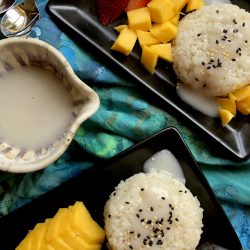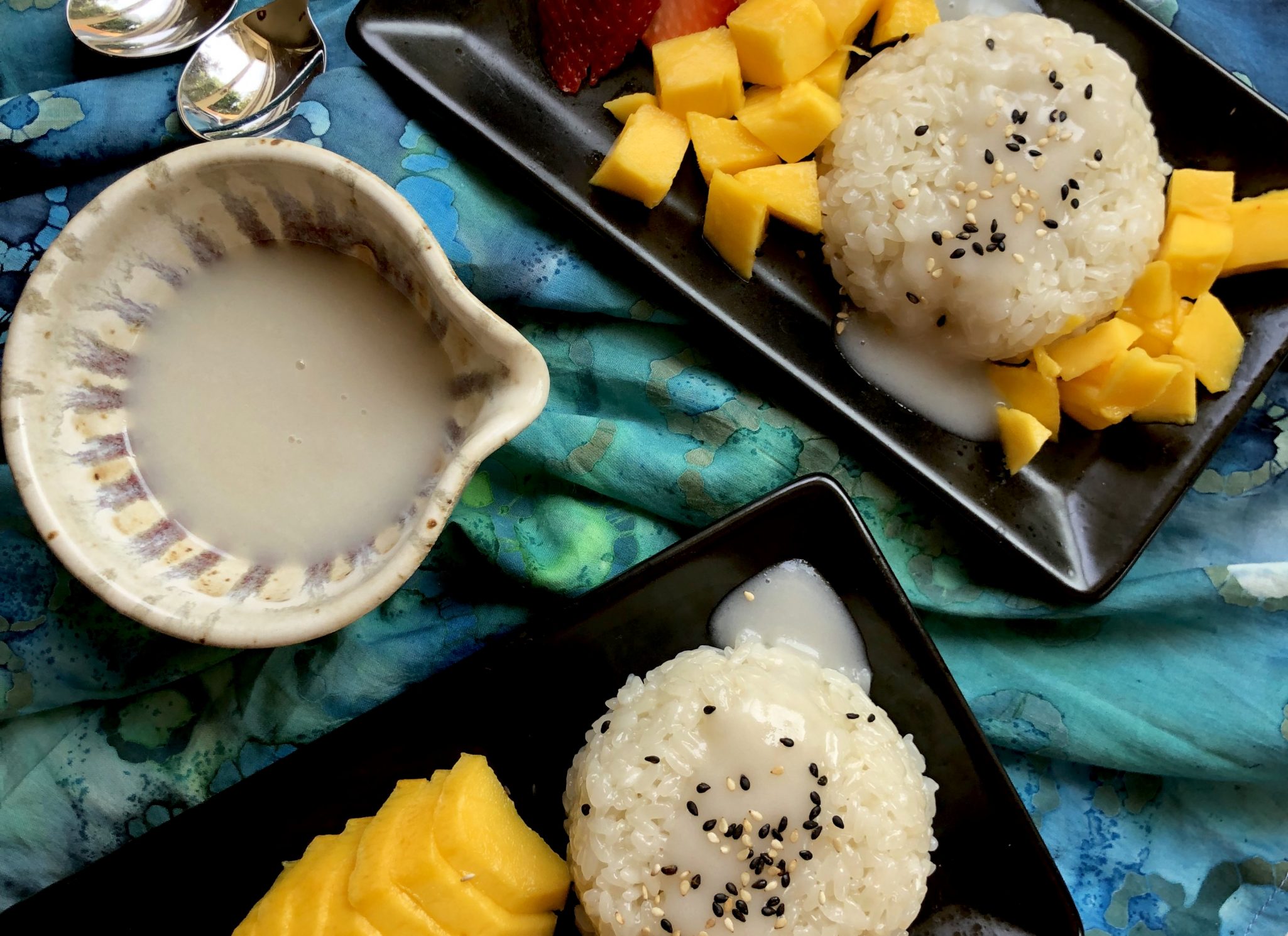
Do You Mandango? Mango Sticky Rice
I recently posted a pic on Instagram of this luscious dessert I had up in San Francisco at U Dessert Story, Mango Sticky Rice Bingsoo. A generous layer of fresh sweet mango precariously perched on a mound of superfine shave ice drenched in sweetened condensed milk, and finely shredded coconut. This mega bowl of bingsoo is flanked by an array of sticky rice, housemade coconut crumble, more sweetened condensed milk, and fresh mango puree. It was mind-bogglingly delicious.
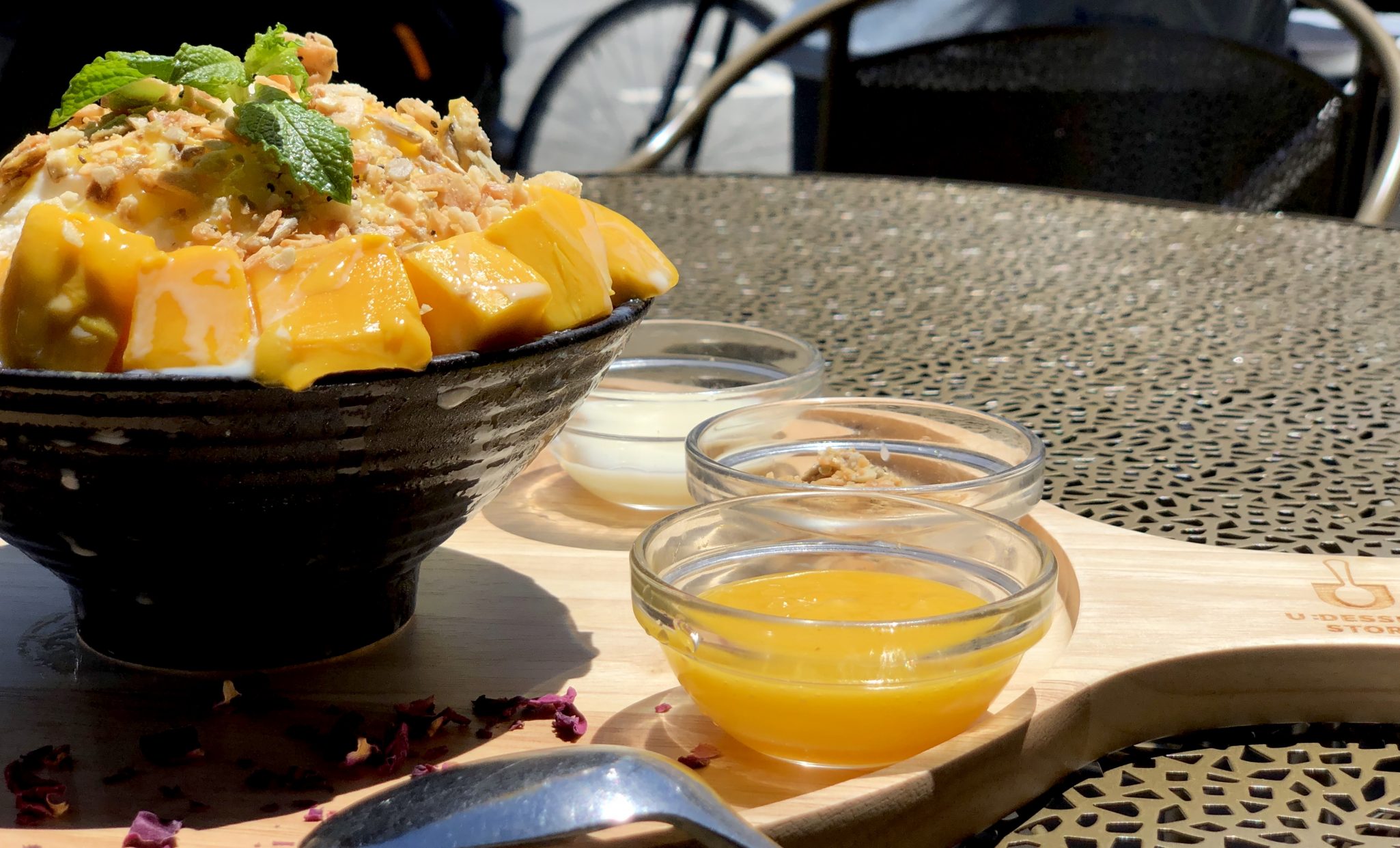
Since that day I have had mango on the brain. I picked up a bunch of Manila mangos, because you can’t just buy one, because I had decided I had to make Mango Sticky Rice. It’s sweet, filling, refreshing, and gluten-free. A classic fixture at Thai restaurants, you’ll be surprised at how easy it is to make at home.
WARNING: Dissertation Ahead + The Ulitmate Rice Guide
The biggest hurdle is probably tracking down the ingredients. Mango Sticky Rice calls for Sweet or Glutinous Rice. This is not regular rice, it is not arborio or risotto rice, and it is not to be confused with sushi rice (short grain) which is stickier than long-grain rice but not actually sticky rice. Sweet rice, also known as sticky rice or glutinous rice, is low in amylose, and high in amylopectin (starches) which allows it to absorb liquids and create that trademark stickiness.
To add to the confusion-sweet rice also comes as short grain or long grain. Thai cuisine uses long-grain sticky rice, while Chinese and Japanese dishes generally use short grain. I used short-grain sweet (glutinous) rice from Koda Farms (Sho-Chiku-Bai) which is a little easier to find (most Chinese, Japanese and Korean markets will carry this) and it’s what I have on hand. I’ll be looking for Thai long grain Sticky rice the next time I’m at an Asian market. I foresee an America’s Test Kitchen session soon.
Glutinous rice absorbs liquids well, so the traditional, easy method for cooking it is to soak the rice for a good couple of hours (2-8 hours) and then steam it. You COULD buy a special bamboo steamer for sticky rice or you could improvise. I lined my steamer with cheesecloth to spread the rice on.
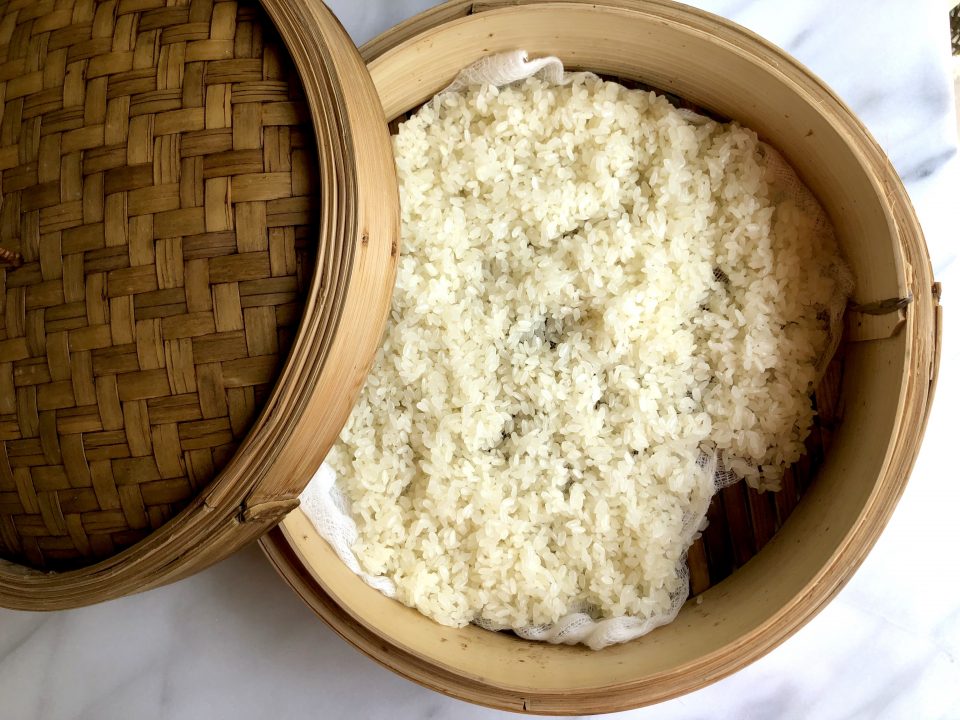
The rice steams for approximately 25 minutes. It will look translucent and should not be chalky in the center. Pull out a couple of kernels and taste them.
While the rice is steaming, prepare the coconut milk that will be used in the rice and as a sauce alongside. Warm coconut milk and add sugar, stir to dissolve. Remove 1 1/4 cups to use in the rice. Add 1 teaspoon of cornstarch, dissolved in 2 teaspoons of cold water, to the coconut milk remaining in the pot. Stir constantly until the sauce begins to thicken. Set aside.
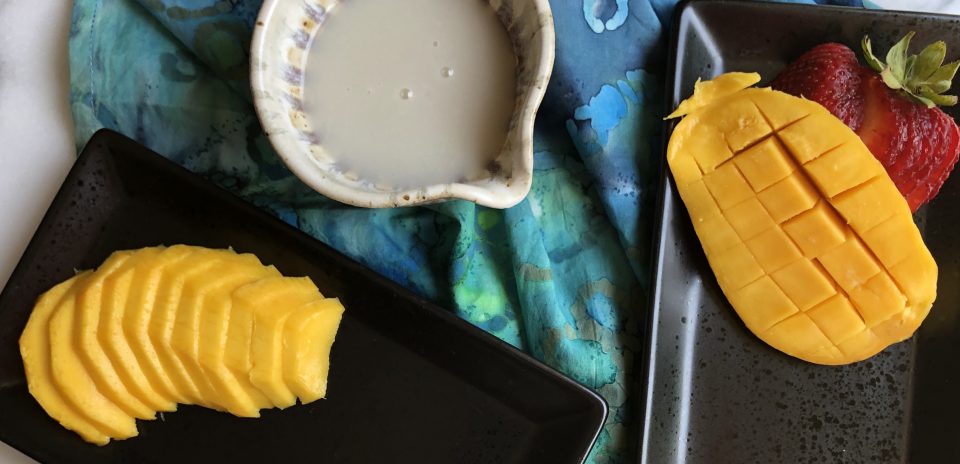
When the rice is done, pour it into a bowl, add the 1 1/4 cups of coconut milk and stir to combine. Cover the bowl and let it sit for 20 minutes so the milk is absorbed by the rice. Stir rice again, cover, and let it sit for a few more minutes.
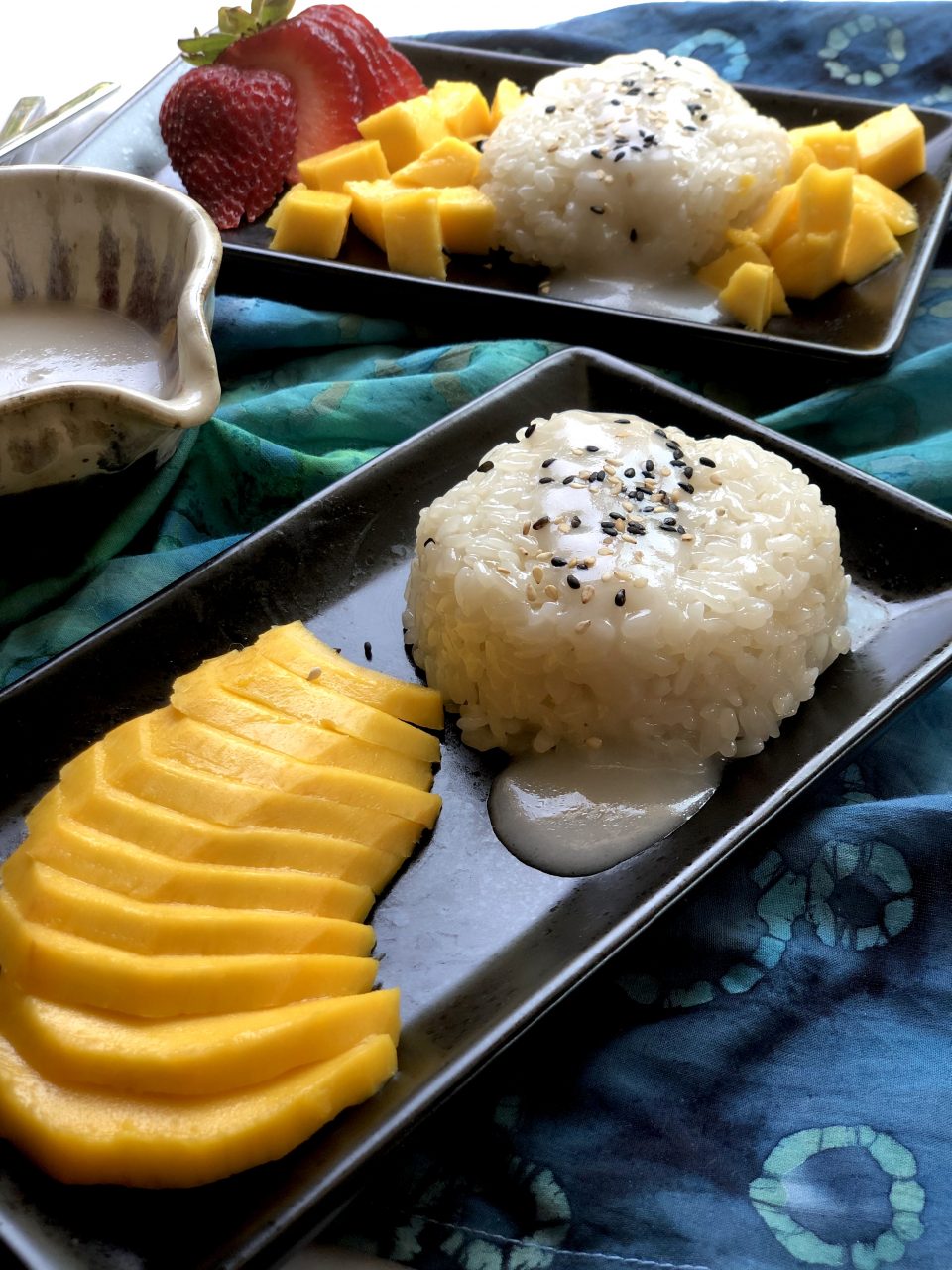
Slice or cube mango and serve alongside a scoop of sticky rice. Drizzle coconut sauce on rice and garnish with sesame seeds. Enjoy!
Mango Sticky Rice
Ingredients
- 1.5 cups Long-grain Sticky Rice (aka sweet or glutinous) can use short grain
- 1 can coconut milk 13.5 ounces, like Chaokoh
- 1/4 cup sugar + 2-4 Tablespoons
- 1/2 teaspoon salt
- 1 teaspoon cornstarch dissolved in 2 t cold water
- 1 big ripe mango or 2 Manila mangoes peeled and sliced or cubed
- Toasted sesame seeds for garnish black or white
- fresh strawberries for garnish optional
Instructions
- Rinse the sticky rice with tap water and use your hand to gently stir it. Drain the water to remove the excess starch. Repeat once, then add water to cover. Soak the sticky rice for a minimum of 2 hours, up to 8 hours. Rinse again and drain the water.
- Transfer the rice to a heatproof bowl, add about 2 inches of water to your steamer (not into the rice), place the heatproof rice bowl on the steaming rack in the steamer, and cover the steamer. Turn to medium-high heat to bring the water to a boil. When the steam starts to come out of the pot, turn to medium heat. Steam for 20 to 25 minutes, until the rice is cooked through, with no hard raw bits in the middle. Or use a steamer rack lined with cheesecloth. Spread rice evenly over cloth and steam as directed above.
- While rice is steaming, add can of coconut milk, 1/4 cup + 2 T of sugar, and salt to a saucepan. Cook over medium heat until the mixture is hot and the sugar is melted. Do not bring the coconut sauce to a boil. Taste for sweetness, if it needs more sugar, add another 1-2 tablespoons. Remove 1-1/4 cups sauce to be used with the rice.
- Carefully remove the sticky rice bowl from the steamer with your oven mitts on. Pour the 1-1/4 cups of sauce over the bowl of rice. Stir to mix well. Allow to stand covered for 20 minutes. Remove cover and stir the rice again. Allow mixture to sit another few minutes.
- For the remaining sauce, combine the cornstarch and 2 teaspoons water in a small bowl. Stir to completely dissolve the cornstarch. Over medium-low heat, remaining sauce to a small saucepan. Add half of the slurry to the sauce. Stir immediately to thicken the sauce. You can adjust the thickness of the sauce by slowly adding a bit more water or cornstarch slurry, if needed. The sauce shouldn’t be too thick, but should coat the back of a spoon.
- Serve when the rice mixture and the sauce cool to room temperature. You can serve it or store the extra sauce and the sauce-rice mixture separately in the fridge until ready to serve, up to 3 days. The sauce will further thicken when cooled.
- To serve, transfer the coconut rice into serving bowls or plates. Place the sliced mango on the side. Pour a few spoonfuls of the extra coconut sauce on top of the rice. Garnish with toasted sesame seeds and fresh sliced strawberries if desired.
Notes
- If you use refrigerated sticky rice, you can gently heat it in the microwave to bring it to room temperature before serving, for a better texture. However, it’s highly recommended to serve the rice when it’s fresh, for best results. Do not freeze the sticky rice, as it will create a very tough texture.
- Use a small ramekin to mold sticky rice and place on the plate.
